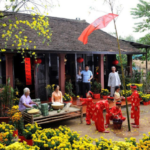The tradition of worshiping sugarcane during Tet has been around for a long time, but not everyone understands the meaning behind it.
The significance of using sugarcane to worship ancestors during Tet Nguyen Dan
On the occasion of Tet Nguyen Dan, in addition to the five-fruit tray, some families will prepare two large and straight sugarcane to place on both sides of the ancestral altar.
The chosen sugarcane must be large, straight, with intact leaves, roots, and segments, without any damage from pests.
There are many different explanations for the meaning of sugarcane in worshiping during Tet.

Sugarcane is believed to symbolize connection, the intersection between heaven and earth, between yin and yang. The leaves represent clouds and the sky. Meanwhile, the roots of the sugarcane symbolize the earth and the roots of the family. The segments of the sugarcane are like stairs connecting heaven and earth, connecting yin and yang, allowing the spirits of ancestors to come back to celebrate Tet with their descendants. Sugarcane is also considered a sacred object for ancestors to return to the heavenly realm after 3 days of Tet.
In addition, offering sugarcane is also a way for ancestors to convey their wishes. Sugarcane has a sweet taste, symbolizing a beautiful and fortunate life. The strong and tall stalks of sugarcane represent success and abundant health…
There are also many other interpretations related to the practice of displaying sugarcane during Tet Nguyen Dan. Sugarcane is also believed to be related to legends of the origin of the Buddha. The legend of sugarcane is recorded in “Phap Ban Hanh Tap” Volume 5 of the Buddhist Canon. Therefore, at the beginning of the year, when visiting temples, climbing high hills, people often buy sugarcane as a walking stick to help the process of climbing up the temple easier and also symbolize returning to the roots. Sugarcane is seen as a symbol of the ancestral lineage of the Buddha. Worshiping sugarcane is also considered a way to worship the root of the Buddha.
This information is for reference and contemplation purposes.






































